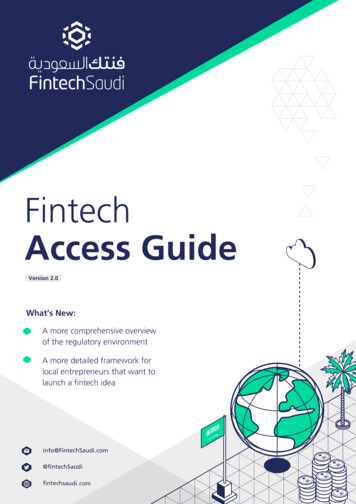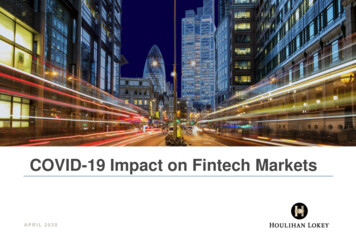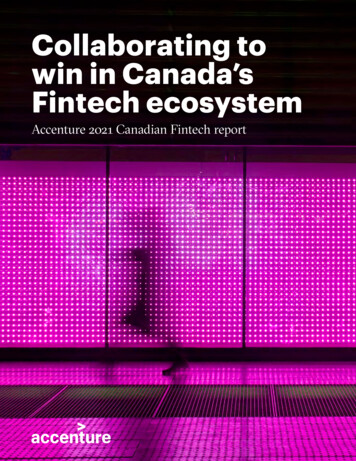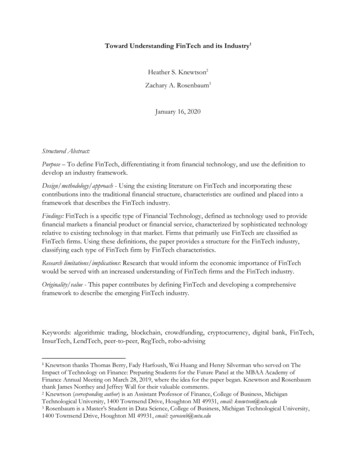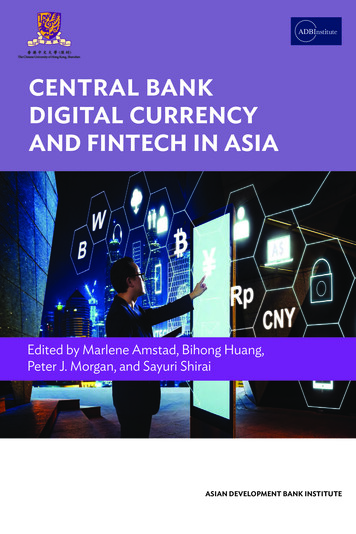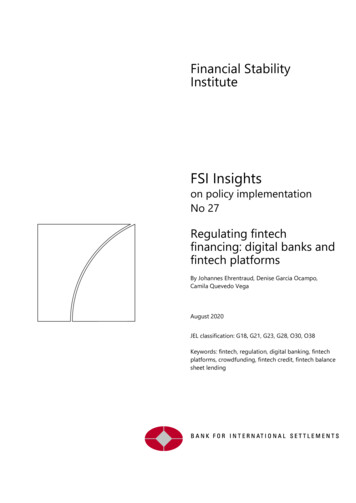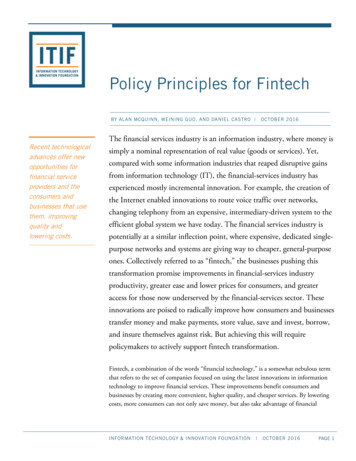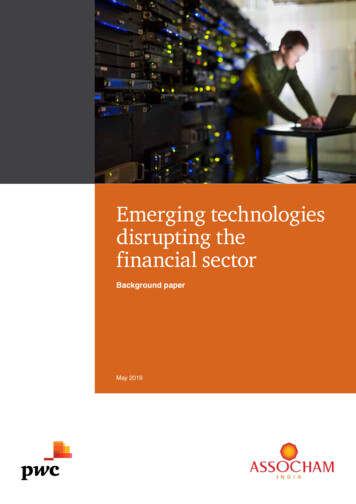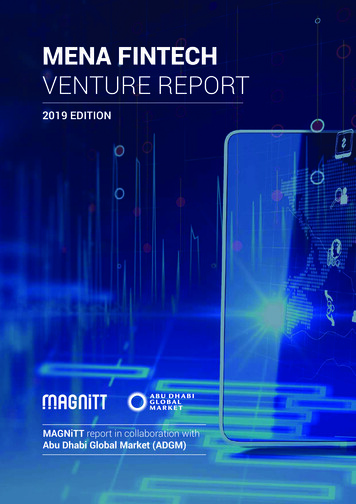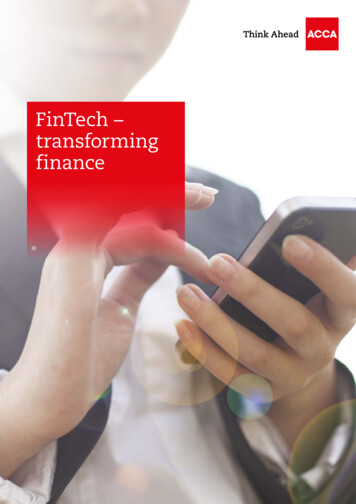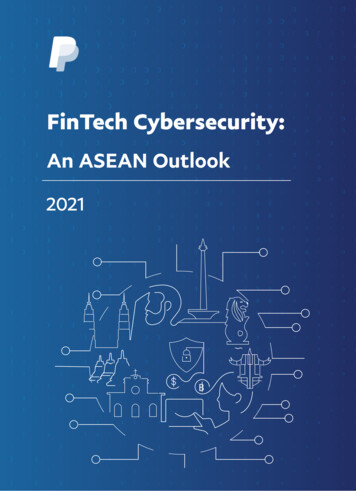
Transcription
1 PwC Global Fintech Report 2019Crossing the lines:How fintech is propelling FS and TMT firmsout of their lanesGlobal Fintech Report 2019
2 PwC Global Fintech Report 2019This is our third survey charting therapid evolution of fintech.Our 2016 Global Fintech Survey, Blurred lines:How fintech is shaping financial services, revealedestablished financial services (FS) organisations’concerns about the threat to their market positionas fintech set new benchmarks for agility, customerinsight and cost.Our follow-up in 2017, Redrawing the lines:Fintech’s growing influence on financial services,highlighted the shift towards collaboration asstartups realised they didn’t have the scale orcustomer trust to compete with long-establishedFS organisations head-on, while FS looked tofintech partnerships to help strengthen operationalefficiency and boost innovation.Contents3Introduction4Key findings and insights5The current landscape10 What will determine winners and losers15 How to position your firm for success23 Conclusion24 Methodology27 PwC technology tools28 Contacts
3 PwC Global Fintech Report 2019IntroductionIt used to be that financial services (FS) companies and technology, media andtelecommunications (TMT) companies travelled side by side, sometimes on the sameroads but not usually in each other’s lanes. But now, the lines between FS and TMTfirms have blurred to the point that the roads are a free-for-all and previously distinctsectors are colliding. Many TMT companies are applying for FS licences, and FSorganisations have begun calling themselves technology companies.Fintech, or financial technology, is at the epicentre of this transformation. The FSand TMT industries are both using it to sharpen operational efficiency, lower costs,improve customer experience and heighten the appeal of their products and services.They’re also carving out new commercial possibilities. Digital-only banks are offeringredesigned client propositions and cost profiles. Investment managers are deployingfully customised robo-advice. Insurers are using sensors to monitor people’s healthand help prevent illness. And according to a recent PwC survey, consumers are readyfor the digital shake-up. The question is no longer whether fintech will transform FS,but which firms will apply it best and emerge as leaders.In this year’s Global Fintech Survey, we polled more than 500 FS and TMT executivesworldwide and analysed their responses. We think the winning companies will bethose that not only embrace fintech-driven business models but figure out how tonavigate wider and more crowded lanes with approaches that make the most of FSand TMT’s combined strengths.This report explores the current fintech landscape, the factors that will determine thelikely winners and losers in coming years, and the steps that organisations can taketo put themselves in the best position to lead.What is fintech?Fintech is a combination of technology andfinancial services that’s transforming the wayfinancial businesses operate, collaborate, andtransact with their customers, their regulators,and others in the industry. All types of companies,from startups to tech companies to establishedfirms, are using fintech.In recent years, many variations of fintech haveemerged that draw on cutting-edge technologiesspecifically tailored for certain sectors or functionswithin the FS ecosystem, such as regtech andinsurtech.
4 PwC Global Fintech Report 2019Key findings and insightsAdopting a fintech-centredstrategy is paramountFS should look to TMT for ideasabout how best to use fintechFS and TMT should look toeach other and retrain to fillskills gapsFirms should push cross-sectorfusion furtherPwC’s survey found that 47% of TMT and48% of FS organisations have embeddedfintech fully into their strategic operatingmodel. Also, 44% of TMT and 37% of FSorganisations have incorporated emergingtechnologies into the products andservices they sell.The FS executives we surveyed thinkthat using fintech to improve the easeand speed of their service will be keyto retaining customers. But we thinkpeople expect ease and speed, so firmsthat focus their fintech efforts on theseattributes might only meet customers’expectations and not differentiatethemselves, especially when competingwith digitally intuitive TMT businesses.Our survey showed that 80% of TMT and75% of FS organisations are creating jobsrelated to fintech. Yet 42% of both TMTand FS organisations are struggling to fillthese roles. While 73% of FS organisationsare hiring from the technology sector, only52% of TMT firms are looking to recruitfrom FS. It’s our position that finding waysto attract people from TMT to FS, and viceversa, will be important to future successbecause each sector needs the other’sexpertise. Upskilling will also be important,as will the right mergers, acquisitions andjoint ventures.Among organisations that are planning topursue an acquisition, strategic allianceor joint venture to drive growth via fintech,78% of TMT and 76% of FS firms aretargeting businesses within their ownsectors. Fewer than half (44% of TMT and47% of FS organisations) are targeting acompany specialising in fintech.Executives who’ve already fully engagedwith fintech are more likely than thosewho haven’t to be very confident abouttheir future revenue growth and abilityto outstrip the competition. Many firms,though, are still stuck in the developmentand pilot stages, and therefore haven’tseen a return on investment. In our view,those firms are at risk of being one step —or more — behind the market.TMT leaders see personalisation asthe key to keeping customers. In amarketplace that’s moving rapidly towardsmass customisation, we expect that usingfintech in this way is more likely to createdifferentiation, so it would be good forFS firms to adopt a TMT approach in thiscase. In fact, FS companies that don’t willget left behind.At a time when FS firms are striving tosharpen their technology capabilitiesand TMT needs product and regulatoryexpertise to compete in the FS market, wethink firms will miss opportunities if theydon’t pursue more cross-sector fusion.
5 PwC Global Fintech Report 2019The current landscapeEmerging technologies have given companies a low-cost way to create convenient,personalised, data-intuitive products and services. Fintech has also loweredthe barriers to entry for firms — from established FS groups to startups to TMTentrants — and has therefore created a complex web of cooperative competition, or‘coopetition,’ and collision.The technologies executives think will drive changePwC’s survey shows that FS and TMT executives have different ideas about whattype of fintech will drive change, but they have similar struggles in executing theirdigital transformation strategies. More than half of FS leaders believe artificialintelligence (AI) will create the biggest change in how financial services are deliveredover the next two years. A prominent example of this technology is robo-advice.TMT executives think the Internet of Things (IoT) will be the game changer. Anexample would be sensors used in pay-as-you-drive insurance (see Exhibit 1).In an era of increased focus on data, hyper-personalisation and ‘always-on’connectivity, it’s unsurprising that AI and IoT top the list. But our survey highlightsrecurring challenges and concerns in implementing these technologies, including longdelays in developing market-ready products and services, and difficulties managingregulation, safeguarding data and earning customers’ trust. In asset and wealthmanagement (AWM), for instance, robo-advice and automated exchange-tradedfunds pose a significant challenge to traditional delivery models.Only 30% of insurers in our survey think IoT will be transformational, which issurprising given the potential for insurers to use it to make risk management moreproactive and develop new business models in areas such as equipment and healthmonitoring and maintenance.
6 PwC Global Fintech Report 2019Exhibit 1: Technologies leaders think will drive changeIn your opinion, which technologies are set to transform the way financial services are delivered within the next two years?TMTFS52%Internet of Things (IOT)36%51%Artificial intelligence56%48%5G39%45%Cloud43%44%Big data44%41%Blockchain40%40%Robotic process automation31%40%Voice technology, including natural language processing29%40%Biometrics identity management28%Base: All TMT respondents (260), Don’t know (1%); all FS respondents (248), Don’t know (0%)Source: PwC Global Fintech Survey 2019
7 PwC Global Fintech Report 2019Customers need quick, convenientand personalised service. Fintech canhelp to offer such service.”Julien CourbeGlobal Financial Services Advisory LeaderPwC USExhibit 2: Almost half of both TMT and FS firms have fully embedded fintechTo what extent is fintech part of your organisation’s strategy?TMT3% 18%32%47%Who’s ahead in leveraging fintechAlmost half of all firms in both FS and TMT haveembedded fintech fully into their strategic operatingmodel, and many have fintech-based products andservices. In certain sectors, the numbers are even bigger.More than half of banking and capital markets (BCM)organisations have incorporated emerging technologiesinto commercial banking and personal loans, and anadditional 20% plan to do so in the next two years. InAWM, asset managers are ahead of wealth managers onincorporating emerging technology (57% to 48%). Butall of these percentages leave a significant proportion ofcompanies that have no current plans (see Exhibit 2).Chinese companies are among those out in front onembedding emerging tech. More than three-quartersof those surveyed have insurtech-supported productsand services, and almost two-thirds offer robo-advice.In part, this is because Chinese regulators are keen topromote fintech-enabled innovation in order to improvecompetition and bring services to unbanked consumers.Businesses there also have been able to act quickly onemerging tech — such as facial recognition, which canfacilitate customer identification and virtual banking —because they’re not held back by legacy infrastructure.FS4% 12%36%48%n No formal strategyn We have an informal strategy that we have discussed internally but not documentedn We have a formal, documented fintech strategy, but it is not fully embedded across our strategic operating modeln Fintech is fully embedded across our strategic operating modelOrganisations in China and Brazil are more likely to have fully embedded fintech across their strategic operating model (58%and 55%, respectively), compared with organisations in the US and Germany (37% and 36%, respectively)*Multinational and large corporations are more likely to have fully embedded fintech across their strategic operating model(53%), compared with middle-market or micro, small and medium-sized enterprises (39% and 34%, respectively)Base: TMT (260), Don’t know (0%); FS (248), Don’t know (0%)*Caution: low number of responsesSource: PwC Global Fintech Survey 2019
8 PwC Global Fintech Report 2019Where collision and fusion are happeningAfter years of tracking the competition and collaborationbetween FS and TMT firms, we are now seeing pocketsof convergence. As far back as 2014, Citigroup ChiefExecutive Michael Corbat said, “In many ways, we seeourselves as a technology company with a bankinglicence.” Similarly, in 2017, Lloyd Blankfein, then chairmanand CEO of Goldman Sachs, declared, “We are atechnology firm.” And insurance company Lemonade isreplacing brokers and bureaucracy with bots and machinelearning, promising as a result zero paperwork and instanteverything.Hugely successful TMT payment platforms such asAlipay and PayPal offer striking examples of collisionand crossover. So does the dominance of businessessuch as Alibaba and Tencent in consumer lending andretail investment, and the ability of telecom businessesin Africa to create a leading mobile-delivered financialinfrastructure.The introduction of virtual banking licences for digitalbusinesses in Hong Kong could take convergence to anew level there, too. TMT companies are cooperating withestablished FS groups and other companies in applyingfor the licences and are set to roll out these operationssoon. This could severely disrupt the traditional bankingindustry in Hong Kong, because digital banking is moreefficient and less expensive. Australia offers similarrestricted licences for its ‘neobanks,’ which also conductall operations online. And other markets, includingSingapore, have recently announced similar moves.Europe, too, is seeing disruption as a result of challengerbanks unencumbered by the legacy, complexity and coststructures of their longer-established counterparts. Thesechallengers are harnessing fintech to sharpen customerservice with offerings such as budgeting apps andno-fee currency exchange. They have yet to challengethe established groups in terms of market share, butthey’re raising the bar for customer expectations and areoperating at a fraction of the cost of their competitors.US startups and TMT giants now have a firm footholdin less regulated segments, such as payments, butthey’re in no rush to set up their own banks and otherFS businesses, owing to concerns about licensingrequirements, costs and compliance. Instead, they’rekeen to sell their services and innovation capabilities toestablished FS organisations.Collision and fusion are complicated, though. It’s ourposition that in the near future, although we envisiongrowing overlap between TMT and FS in certain areas,such as payments and regulation, TMT and FS firms willremain distinct in other areas.Where there isn’t fusion, there’scoopetitionWhere fusion isn’t happening, we see coopetition, whichis the collaboration that occurs when the interests ofFS and TMT businesses diverge. Open banking, whichcreates a digital shop window for the best productsand services available in the marketplace, is perhapsthe most significant manifestation of this trend. We alsoIn China, convergence is gatheringpace. At the top of the market, we’veeven seen regulators seeking tomatch up the big four TMT firms withthe big four banks and get them towork together — you could call itan arranged marriage. The TMT firmprovides the tech enablement and theFS firm delivers the end product.”Wilson ChowGlobal Technology, Media and Telecommunications LeaderPwC China
9 PwC Global Fintech Report 2019see it when TMT companies share mutually beneficialtechnology, supporting employee and — most importantly— customer relationships with FS firms, or when FSorganisations bring products, markets and regulatoryexpertise to the party for TMT.For instance, the FS executives we surveyed mainlyview fintech collaboration as a way to gain access totechnology and innovation. For TMT leaders, though,access to customers’ data could be the big draw.For example, if a telecom company wants to offerpayment services using support from an FS firm, it mayjust want to add functionality rather than make money.The payments data could also offer a gold mine of insightinto customer preferences and behaviour. In situationslike this, FS organisations have to determine howopen they want to be and what the right balance is inproviding convenience and experience while protectingcustomer data. Clarity and agreement on objectives aretherefore essential.
10 PwC Global Fintech Report 2019What will determinewinners and losersCompanies that have embraced fintech are reshaping the marketplace, andthose that haven’t are being left behind. In fact, three-quarters of the FS and TMTexecutives we surveyed said they’re stepping up their fintech investment in the nexttwo years. More than 90% are very or somewhat confident that fintech will deliverrevenue growth over the next two years (see Exhibit 3).Exhibit 3: Consensus that fintech will drive growthHow confident are you that fintech will support your organisation to deliverrevenue growth over the next two years?TMTFSConfident 95%Confident 94%NotConfident 4%NotConfident 6%Where companies can winCustomer relationships are one of the big prizes firms are chasing, so the ability todeliver a premium experience will probably help determine the winners and losers.But while FS organisations focus on applying fintech to improve ease and speed ofservice, which we view as table stakes, TMT firms are differentiating themselves withpersonalisation and a superior experience by embedding FS activity directly into theservice they provide (see Exhibit 4). AWM organisations, too, are focussing more onpersonalisation than BCM companies and insurers.Tellingly, more than 90% of both FS and TMT executives believe TMT has ledthe way in setting new standards for customer expectations by offering moreconvenient products and services through the customer life cycle. However, manyonly ‘somewhat’ rather than ‘strongly’ agree with this statement, and some FSorganisations are harnessing fintech to catch up fast.n Very confident n Somewhat confident n Not very confident n Not at all confidentOrganisations in Brazil are more likely to be very confident (73%) that fintech willdeliver revenue growth over the next two years, compared with organisations in theUS and UK (47% and 41%, respectively)Organisations with an embedded fintech strategy are more likely to be veryconfident that fintech will deliver revenue growth over the next two years, comparedwith those that have a formal strategy that isn’t fully embedded (60% vs. 43%)Multinational and large corporations are more likely to be very confident thatfintech will deliver revenue growth (60%), compared with middle-market or micro,small and medium-sized enterprises (38% and 20%, respectively)Base: TMT (260), Don’t know (1%); FS (248), Don’t know (1%)Source: PwC Global Fintech Survey 2019
11 PwC Global Fintech Report 2019Exhibit 4: TMT and FS firms differ on how best to use fintech to retain customersWhat do you think are the most important areas for customer retention in the context of emerging technology (e.g., artificial intelligence, robotics, Internet of Things)?TMTFS13.2%Personal digital contact11.5%Personalised service10.8%10.2%Trust10.9%9.4%Faster service and processes12.2%9.2%Ease of use13.1%8.9%Cost (cheaper, lower rates)8.1%8.6%Design of interface and platform7.9%7.7%Product design8.5%7.6%Personal human contact7.1%7.1%24/7 accessibility7.2%6.7%Rewards5.1%Base: All TMT respondents (260); all FS respondents (248). Ranked based on index analysis; excludes “don’t know” and “other” responsesSource: PwC Global Fintech Survey 20199.1%
12 PwC Global Fintech Report 2019Trust will be another battleground in customer retention.Both the TMT and FS executives surveyed cited trust asimportant for customer retention. This is where FS hasa clear edge. Despite some erosion of faith in FS overrecent years, people still trust banks with their savings,AWM businesses with their investments and insurerswith protection against loss. And building up that trusttakes time, which is one of the reasons we’re seeingTMT become interested in acquiring and partnering withestablished FS businesses. However, FS organisationsshouldn’t be complacent, because young people don’thave the same level of trust as previous generations andtheir loyalty can’t be taken for granted.TMT has an advantage in its lead in deploying digital andmobile technologies and the improved connectivity thatcomes with them. Areas where these technologies couldboost operational capabilities, especially when deployedin conjunction with AI, include facial recognition, realtime data capture and high-definition video conferencing.FS also could use these technologies to broaden thequality and reach of virtual services and pave the wayfor an increasing range of smart contracts that could beexchanged and executed on smartphones. There alsoare opportunities to speed up and improve the security ofknow your customer (KYC) verification.Given the enormous flow and volume of data in the cloud,tech companies that currently provide these platformsto process and store this data efficiently could also havean advantage and provide value-added services to otherfirms, such as data analytics and AI applications.When we asked executives about the extent to which theircompanies have incorporated emerging technologies intotheir products and services, further gaps between leadersand laggards became evident (see Exhibit 5).Exhibit 5: FS organisations are slightly behind TMT firms in moving products to marketTMT respondents: Thinking about your fintech products/services that are at the most mature stage, where would youplace your organisation on the scale below in relation to the implementation of fintech products/services?FS respondents: Thinking about how you are incorporating emerging technology (e.g., AI, blockchain, robotics, fourthindustrial revolution) into your existing products or developing new fintech products/services, where would you placeyour organisation on the scale below in relation to the implementation of these products/services? Please focus on theproducts/services that are at the most mature stage.Available for customers 44%TMT8%35%12%10%12%22%Available for customers 37%FS11%29%22%8%12%17%n Research stage n Development stage n Pilot stage n Available for customers, but little/no adoptionn Customers are using, but it’s not yet profitable n We are making a profit44% of TMT organisations have fintech-based products or services available to their customers, compared to 37% of FSorganisations. However, more than a fifth (22%) of FS organisations have products or services in the pilot stage.Base: TMT (260), Don’t know (0%); FS (248), Don’t know (1%)Source: PwC Global Fintech Survey 2019
13 PwC Global Fintech Report 2019Exhibit 6: C-suite executives not leading fintech efforts at many firmsWhich of the following best describes the most senior person in your organisation who is responsible for digital/innovation/technology?C-suite executiveDirectorHead of departmentSenior managerManager33%41%35%33%21%19%7%5%Head of department or belowresponsible for technologyTMT: 32%Perhaps another indicator of which firms are poisedto lead the pack is whether or not they have C-suiteexecutives championing their digital innovation efforts.Our survey revealed that only 33% of TMT and 41%of FS organisations do. In China, the proportion ofC-suite–directed operations is significantly higher(53% for TMT and 46% for FS), and organisationsthere are more likely to be ‘very confident’ about theirprospects for revenue growth (83% for TMT and 92%for FS) than the survey population as a whole (seeExhibit 6).Given most firms’ slow speed-to-market, along withthe fact that C-suite leaders aren’t directly responsiblefor driving the innovation agenda at many firms,it’s hard to see how more than 90% of our surveyrespondents can be confident about their prospectsfor revenue growth. But this could be why more than40% are only ‘somewhat confident.’FS: 26%4%2%n TMT n FSOrganisations in China are more likely to have a C-suite executive responsible (50%), compared with organisations in theUK (32%) and Brazil (25%)Multinational and large corporations are more likely to have a C-suite executive responsible (42%), compared withmiddle-market companies (29%)Companies with revenues of US 5bn-plus are significantly more likely to have a C-suite executive responsible (44%),compared with companies with revenues of less than US 1bn (31%)Base: TMT (260); FS (248)Source: PwC Global Fintech Survey 2019“The really big changes have to betop-down. They have to be strategic.They have to be something thatleadership, the board, and theexecutives are closely involved inand have decided the organisationneeds to pursue.”John GarveyGlobal Financial Services LeaderPwC US
14 PwC Global Fintech Report 2019Where companies could loseWhere do survey respondents see the biggest threats?TMT executives think tech, social media and startupcompanies will be most disruptive in fintech over thenext two years, primarily because of their innovativeculture and tech capabilities. Big Tech’s move intocryptocurrency is an example of this. The potential threatfrom established financial institutions isn’t on most TMTexecutives’ radar, despite the market reach, regulatoryexpertise and foundation of trust that they have.FS executives also are worried about the threat fromtech and startup companies, and they are concernedabout whether or not their senior leadership reallyunderstand fintech.TMT and FS executives share concerns about data,regulation and legacy systems. There is worry, inparticular, that regulation creates a barrier for emergentfintech (see Exhibit 7). These concerns highlight thatexecution is the key to strategy. Cybersecurity, forinstance, has to be ingrained into the way people thinkabout new business opportunities and capabilities. It can’tjust be something that systems teams are going to fix.Exhibit 7: Top challenges to fintech growthWhat do you perceive as your organisation’s greatest challenges to implementing a fintech strategy? Please rank the top five, where one is the biggest challenge.TMTFSSecurity, compliance and data-privacy risksand related issues are a concern1stSecurity, compliance and data-privacy risksand related issues are a concern1stRegulation is limiting our ability to implementthe right solutions2ndWe have too many legacy systems.New systems risk adding complexity2ndWe have too many legacy systems.New systems risk adding complexity3rdRegulation is limiting our ability to implementthe right solutions3rdOur workforce does not have the relevant skillsand experienceOur senior leadership lacks understanding ofthe benefits fintech can provideOur existing omnichannel infrastructure is notperceived to be good enoughOur workforce does not have the relevant skillsand experienceOur fintech strategy lacks clarityOur data-management practices and datalandscape do not support fintechOur data-management practices and datalandscape do not support fintechOur current culture does not support innovationOur senior leadership lacks understanding ofthe benefits fintech can provideOur existing omnichannel infrastructure is notperceived to be good enoughOur current culture does not support innovationOur fintech strategy lacks clarityBase: All respondents: TMT (260); FS (248). Ranked based on index analysis; excludes “don’t know” and “other” responsesSource: PwC Global Fintech Survey 2019
15 PwC Global Fintech Report 2019How to position your firmfor successAs gaps between leaders and laggards grow, FS and TMT businesses need tomove quickly if they’re going to capitalise on fintech’s potential and avoid beingmarginalised.Recognising the different starting points and what is likely to be a triangular playamong TMT, fintech and established FS companies, here’s how firms can get up tospeed across four key growth areas: digital, workforce transformation, deals and riskand regulation.DigitalPriorities: Digital advances have the potential to revolutionise capabilities and openup new markets. Robo-advice, for instance, highlights the evolving customer offerbecause it paves the way for customised investment solutions for mass-marketconsumers that used to be available only to high-net-worth clients.Capitalising on these and other fintech-enabled commercial openings requires theability to leverage technology in new, personalised and real-time offers. Success alsodemands a clear understanding of customer expectations. Customers need to trustthe technology, think that it offers better value for their money than current productsand services, and believe that the institution will use their data responsibly.Challenges: Translating opportunity into successful execution is difficult. Most techdevelopments are still stuck in the lab. For example, despite executives citing AI asthe technology that’s most or second most likely to transform financial services(in FS and TMT, respectively), fewer than 40% of executives surveyed have movedAI projects beyond the pilot stage into implementation.
16 PwC Global Fintech Report 20193. Make cybersecurity a business priority: The factthat both TMT and FS organisations see security,compliance and data privacy risks as their greatestchallenge in implementing a fintech strategy highlightsthe extent to which work needs to be done to bring cyberinto the forefront of business planning, product innovationand go-to-market strategies, rather than just leaving it toIT. This is a trust rather than just a systems issue.Steps to take1. Personalise and customise: Our survey suggests thatFS businesses are at risk of losing out to TMT competitorsthat are better able to match experience and solutionsto customers’ individual needs and preferences. Sharpuse of AI, IoT and big data is critical in creating thenecessary customer insight and agility to meet demands.It’s also a matter of culture; firms need to embrace datadriven decision making and move from product push tocustomer pull.2. Balance tech and a human touch: Most consumerswant the reassurance of some human oversight. They alsowant access to a human adviser for key decisions. If welook at robo-advice as an example once again, high-networth investors still get this human touch, but it’s actuallyless affluent consumers who most need it and are firmlyin regulators’ sights. We’re therefore seeing a growingshift towards hybrid human and robo-advice strategies,with even some of the pure-play robo-advisers now hiringhuman advisers.Are FS and TMT businesses getting this all-importantbalance between human and machine right? As oursurvey confirms, this tends to be an area where TMT isstrong, and that could give it an edge when moving intoFS markets — 45% of TMT respondents strongly agreethat they’re getting the balance right. Within FS, 43% ofAWM respondents strongly agree, compared with 36%in BCM and 31% in insurance. But the fact that personalhuman contact is near the b
How fintech is shaping financial services, revealed established financial services (FS) organisations’ concerns about the threat to their market position as fintech set new benchmarks for agility, customer insight and cost. Our follow-up in 2017, Redrawing the lines: Fi
